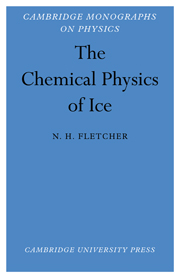Book contents
- Frontmatter
- Contents
- Preface
- Note on Units
- CHAPTER 1 The water molecule
- CHAPTER 2 Structure and energy of ordinary ice
- CHAPTER 3 Other forms of ice
- CHAPTER 4 Liquid water and freezing
- CHAPTER 5 Crystal growth
- CHAPTER 6 Thermal properties and lattice dynamics
- CHAPTER 7 Point defects
- CHAPTER 8 Mechanical properties
- CHAPTER 9 Electrical properties
- References
- Subject Index
CHAPTER 8 - Mechanical properties
Published online by Cambridge University Press: 21 May 2010
- Frontmatter
- Contents
- Preface
- Note on Units
- CHAPTER 1 The water molecule
- CHAPTER 2 Structure and energy of ordinary ice
- CHAPTER 3 Other forms of ice
- CHAPTER 4 Liquid water and freezing
- CHAPTER 5 Crystal growth
- CHAPTER 6 Thermal properties and lattice dynamics
- CHAPTER 7 Point defects
- CHAPTER 8 Mechanical properties
- CHAPTER 9 Electrical properties
- References
- Subject Index
Summary
In many parts of the world, ice is an important engineering material. Either it must serve as a substrate to bear the weight of buildings, vehicles and aircraft or else it is an obstacle which must be dug, drilled or blasted to reach something lying below. Sometimes the ice involved is merely compacted snow and sometimes it is very impure, as when formed from sea water, but often, as in glaciers, one deals with masses of almost pure ice of large grain size and with very little included air. In this latter case the properties of the whole mass can be understood quite well from fundamental studies on pure single crystals, while the former situations involve considerations peculiar to the specific environment.
The present chapter is divided into four parts. After a review of elasticity theory, we shall discuss simple elastic behaviour of single crystals of ice, then examine the relaxation processes which take place for periodically varying stresses and finally take up a brief treatment of plastic deformation, creep and related topics.
Elasticity theory
Since treatments of the elastic properties of crystals are often very brief, or at best limited to a discussion of cubic crystals, let us begin by giving a short review of this subject as it applies to hexagonal crystals like ice. We shall follow the development given by Nye (1957), to whose book the reader is referred for a fuller treatment.
- Type
- Chapter
- Information
- The Chemical Physics of Ice , pp. 165 - 197Publisher: Cambridge University PressPrint publication year: 1970
- 2
- Cited by



